 Website:
SCHMERSAL
Website:
SCHMERSAL
Group: SCHMERSAL
Catalog excerpts

L Protection - ATEX Explosion Protection Catalogue I Version 05
Open the catalog to page 1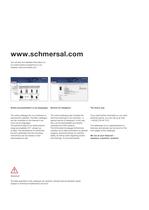
Online documentation in six languages The online catalogue for our customers is permanently updated. The Main catalogue can be consulted on the Internet in as much as six languages. The technical data of our entire product range are available 24/7, always up-to- date. The declarations of conformity, the test certificates and the mounting instructions can be viewed or even downloaded as well. Service for designers The online catalogue also includes the technical drawings of our products – a special service to designers. In this way, they can be downloaded and directly imported into...
Open the catalog to page 2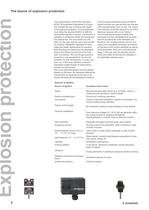
4 The basics of explosion protection The implementation of the ATEX Directives (ATEX: ATmosphères EXplosibles) in Europe has changed the way of thinking with regard to the explosion protection. The manufacturers must follow the directive 94/4/EC to fulfill the harmonised standars in Europe. The directive is obligatory in all Member States and transposed into national law. This was carried out until 2003. On the other side the users have to fulfill the directive 1999/92/EC regarding the basic safety and health requirements for operation. Both Directives are based upon the standards listed in...
Open the catalog to page 4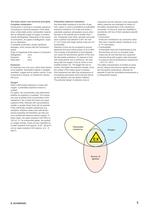
5 The basic physic and technical principles Complete combustion Combustion or burning is a complex sequence of exothermic chemical reactions. A fire starts when a flammable and/or combustible material with an adequate supply of oxygen is exothermically disintegrated. Depending on the speed of combustion, we speak of deflagration, explosion or detonation. A complete combustion causes significant damages, which various with the combustion speed. Order of magnitude of the speed of combustion Deflagration cm/s Explosion m/s Detonation km/s Explosion An explosion can only occur, when three...
Open the catalog to page 5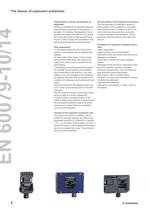
6 The basics of explosion protection Classification of zones and selection of equipment Setting-up installations in potentially explosive areas involves a great deal of precautions to be taken. For instance, the equipment, the resources, the cables and conductors as well as the construction have to meet special requirements. In case of doubt, the consultation of experts during the planning is recommended. Risk assessment It is the responsibility and duty of the user to perform a risk analysis prior to installing new facilities. He must verify where there is a risk of explosion and then...
Open the catalog to page 6
7 Classification of the potentially explosive areas into zones To determine the necessary protective measures to be taken and to select appropriate equipment, the potentially explosive areas have to be classified into zones. This classification of the potentially explosive areas into zones is based upon the frequency and the duration of the presence of the dangerous explosive atmosphere. These framework conditions (frequency, duration) determine the classification and identification of gas explosion risk areas as zone 0, 1 or 2 as well as the required measures to be taken in order to avoid...
Open the catalog to page 7
8 The basics of explosion protection Types of protection General overview Essential requirements The EN 60079-0 describes the essential requirements, which apply to all types of explosion protection. Mechanical protection Mechanical tests are carried out in accordance with EN 60079-0. The enclosures or the exterior part of the enclosure, pushbuttons must withstand highimpact energy. Type of protection „n“ EN 60079-15 The type of protection “n” originally was used as stand-alone standard for use in ATEX category 3G respectively was defined as zone 2 standard in IECEx. This standard has been...
Open the catalog to page 8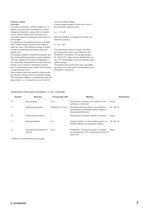
9 Intrinsic safety Principle The type of protection “intrinsic safety” Ex i is based on the principle of limitation of current, voltage and storable energy within an electric circuit. Intrinsic safety does not reduce the potentially explosive substance and/or the oxidizing agent. The ignition of an explosive mixture is avoided, when neither electric sparks nor the effect of heat can occur. The electrical energy is limited in order to keep electrical sparks below the ignition limit. The energy limitation avoids the excessive heating of the electrical apparatus and its surfaces. This also...
Open the catalog to page 9
10 The basics of explosion protection Electrical apparatus and associated apparatus An intrinsically safe electric circuit contains at least one electrical apparatus and one associated apparatus. The electric circuits of the electrical apparatus meet the requirements of the intrinsic safety. The electrical apparatus must only be connected to non-intrinsically safe circuits through associated apparatus. An associated apparatus possesses both intrinsically safe and non-intrinsically safe circuits. To separate the electric circuits, a zener diode or galvanic isolators are used. The EN 60079-11...
Open the catalog to page 10
11 In the control cabinet, the intrinsically safe electric circuits must be clearly marked. The standard prescribes no uniform procedure and only points out that for the marking preferably a light blue colour should be used. However, the neutral conductors of energy cables are usually also marked with a blue colour. In order to avoid confusion, another marking should be used for the intrinsically safe electric circuits in this case. What is important, is a conveniently arranged layout and a spatial separation in the control cabinet. Conductive shields must only be earthed at places located...
Open the catalog to page 11
12 The basics of explosion protection Mechanical explosion protection The general requirements can be summarised as follows: • The equipment must meet all stipulated application requirements (e.g. rough operation, humidity effects, ambient temperature and pressure fluctuations, influence of chemical agents, corrosion, vibrations) (refer to the operating instructions); • Determination and evaluation of the ignition hazards – Apparatus interior (heating due to failure capable of causing ignition inside the device) – Dust deposits (friction between moving parts) – Evaluation of the surface...
Open the catalog to page 12All SCHMERSAL catalogs and technical brochures
-
Safety interlock AZM40
16 Pages
-
Solenoid interlock AZM201
24 Pages
-
Solenoid Interlock AZM150
4 Pages
-
Main catalogue Automation technology
144 Pages
-
Serial Diagnostics
12 Pages
-
Optoelectronic safety devices
28 Pages
-
AS-Interface Safety at Work
40 Pages
-
Catalogue Safety Technology
296 Pages
-
Innovations 2021/2022
28 Pages
-
Product overview
36 Pages
-
Command and signalling devices
124 Pages
-
Packaging industry
28 Pages
Archived catalogs
-
ASSB-4P-SW-V1
2 Pages
-
ASSB-4P-1M12-V1
2 Pages
-
ASSB-2P-FKB-V1
2 Pages
-
ASSB-4P-2M12-V1
2 Pages
-
ASSB-2P-1M12-V1
2 Pages
-
Safety light barriers
4 Pages
-
Heavy industry
24 Pages
-
PROTECT SELECT
10 Pages
























